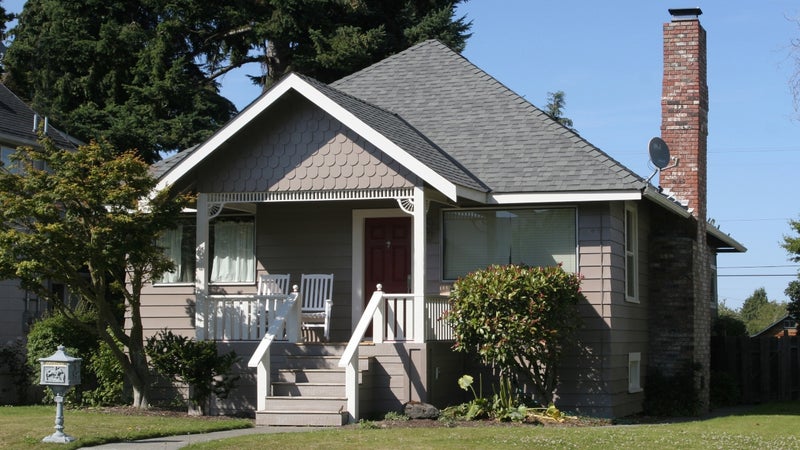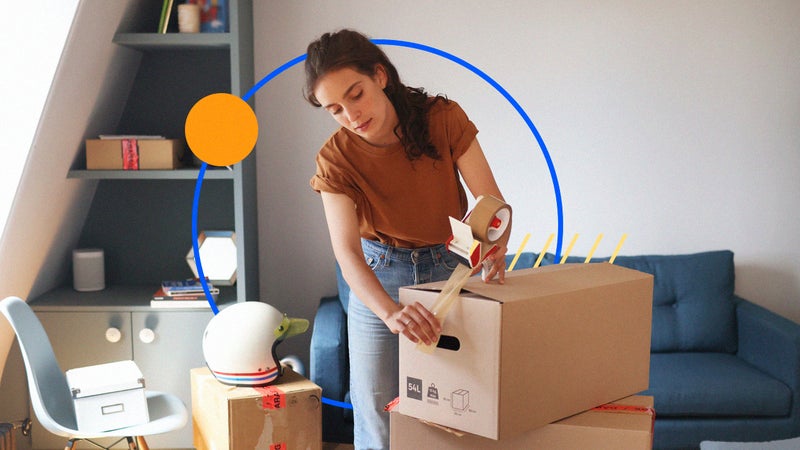What is a down payment?

The Bankrate promise
At Bankrate we strive to help you make smarter financial decisions. While we adhere to strict , this post may contain references to products from our partners. Here's an explanation for .
Our writers and editors used an in-house natural language generation platform to assist with portions of this article, allowing them to focus on adding information that is uniquely helpful. The article was reviewed, fact-checked and edited by our editorial staff prior to publication.
Key takeaways
- The down payment is the initial cash payment the buyer makes during a real estate transaction. It represents a percentage of the total purchase price of the home.
- Down payments can range between 3 percent and 20 percent of the purchase price, depending on the type of mortgage used. Some loan programs don’t require a down payment at all.
- Making a larger down payment upfront reduces your monthly mortgage payments and saves you money on interest in the long run.
Most homebuyers getting a mortgage have to pay a portion of the property’s purchase price upfront. This amount is called a down payment. Exactly how much you’ll need to put down on a house depends on several factors beyond the home’s price. Here’s what to know.
What is a down payment on a house?
A down payment on a house is the initial cash payment the buyer makes during a real estate transaction. The down payment represents a percentage of the total purchase price of the home. If you’re required to make a down payment, you might put down between 3 percent and 20 percent of the home’s purchase price, depending on your savings and what type of mortgage you’re getting.
How do down payments work?
A down payment is part of the homebuying process and a requirement for some of the most popular types of mortgages.
You’ll make your mortgage down payment at closing. These funds are deposited into an escrow account managed by a real estate attorney or settlement officer. Once the deal is finalized, this third party distributes the funds to the seller, who ultimately receives the down payment.
There is a trade-off between your down payment and credit rating: A bigger down payment can offset, to some extent, a lower credit score, while a higher credit score can offset a lower down payment.
For many first-time buyers, the down payment is the biggest obstacle to homeownership. That’s why they often turn to loans with smaller minimum down payments. These loans, though, often require borrowers to purchase some form of mortgage insurance.
Down payment example
A bigger down payment can make it easier to get approved for a mortgage and allow you to buy more house for the same monthly payment, or even less. You might also qualify for a lower interest rate.
Here’s a breakdown of a 30-year fixed-rate mortgage at a 6.5 percent interest rate for a $375,000 home, using data from our mortgage calculator and mortgage insurance estimates from Freddie Mac’s PMI calculator:
| Home price | Down payment | Monthly principal and interest | Monthly PMI | Total monthly payment |
|---|---|---|---|---|
| $375,000 | $11,250 (5%) | $2,299 | $342 | $2,641 |
| $375,000 | $37,500 (10%) | $2,133 | $219 | $2,352 |
| $375,000 | $56,250 (15%) | $2,014 | $89 | $2,103 |
| $375,000 | $75,000 (20%) | $1,896 | $0 | $1,896 |
Note this example does not factor in the potential interest rate savings associated with a larger down payment. For instance, a 20 percent down payment might qualify you for a lower interest rate compared to the rate offered with a 10 percent down payment.
How to choose the best down payment amount
A larger down payment has benefits, but it’s not necessarily the best decision for every homebuyer. Consider these pros and cons:
Pros of a bigger down payment
- Smaller monthly payments: Making a bigger down payment upfront translates to smaller mortgage payments each month. Consider the difference between 3 percent down and 20 percent down on a $400,000 home. With a 30-year loan at a fixed 6 percent interest rate, the bigger down payment translates to a monthly mortgage payment savings of around $400. Use our down payment calculator to run your own scenario.
- Lower lifetime interest charges: Those smaller monthly payments add up to significant savings in the long run. In that $400,000 home example, a 20 percent down payment would save more than $78,000 over the course of a 30-year mortgage.
- Potentially better terms: Lenders like to see larger down payments. By putting more of your own money into the transaction, you’re borrowing less of theirs, which can put you in the running for the lowest rates possible.
- Ability to skip mortgage insurance: If your down payment is at least 20 percent on a conventional or FHA loan, you won’t have to pay mortgage insurance.
Cons of a bigger down payment
- Potential to stretch your savings too thin: If you’re draining nearly all your savings to make a bigger down payment, you’re putting yourself in a precarious position as a new homeowner, especially when an emergency cost or home repair inevitably pops up.
- The need for more time to save: You might be tempted to keep saving up money to make a bigger down payment, but that strategy can backfire. While you’re trying to cut every expense, home prices might still be rising at a pace you can’t keep up with.
Tips to save for a down payment
If you’ve been thinking of buying a house, you’re probably aware that you need to save a substantial amount for a mortgage down payment. Here are some tips for saving for a down payment on a house:
- Budget: Budgeting allows you to direct money toward your savings goals. Take a look at your monthly income and identify areas where you can reduce spending or temporarily halt spending while you’re saving. Take advantage of any extra money by funneling it into your savings account.
- Don’t wait for a windfall: The key to saving for a down payment is getting started as soon as possible, even if you aren’t sure when you plan to buy a home.
- Be strategic about where you put your savings: It’s a good idea to keep your money somewhere that provides a return, like a high-yield savings account or a certificate of deposit (CD). With a CD, keep your timeline in mind. If you know you’ll buy a home sooner rather than later, you might not want to tie your savings up in a five-year CD, for example.
- Explore assistance programs: Look into your options for mortgage down payment assistance, such as applying for grants, low-interest loans or deferred-payment loans.
FAQ about down payments
-
For conventional loans, the minimum mortgage down payment is 3 percent. FHA loans have a minimum down payment of 3.5 percent with a credit score of 580 or higher. For scores between 500 and 579, the minimum is 10 percent. VA loans and USDA loans do not require any down payment, but they are reserved for members of the military and veterans or buyers in rural areas, respectively.
-
Mortgage lenders require a down payment as a hedge against risk. Additionally, if the lender has to foreclose and sell the property, it’s not on the hook for the entire purchase price, which can limit its potential losses if the home is sold for less than the remaining mortgage balance.
-
A down payment benefits the homebuyer in a variety of ways. Making a larger down payment upfront reduces your monthly mortgage payments and saves you money on interest in the long run. By providing a larger down payment, you’ll have more equity in your property and borrow less money. Furthermore, putting down at least 20 percent on a conventional loan means avoiding paying for private mortgage insurance. In a competitive housing market, a substantial down payment can also make your offer more attractive to sellers.



